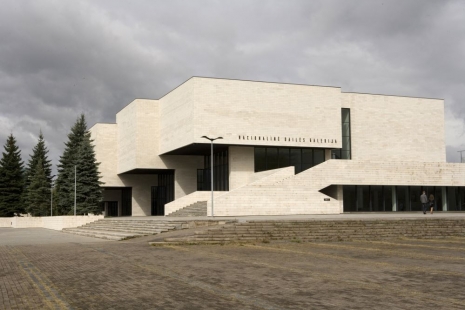The exhibition presents Jonas Mekas’ (1922-2019) work in the expanded sense. It covers his filmic practice as well as his intellectual, organizational, and often bluntly administrative approach to the labour of building and running multiple institutions and fostering new habits of looking at film as an art form. The exhibition focuses on the first three decades of Mekas’ activities, starting with his coming to New York as a displaced person in 1949, through to him becoming a central figure in advocating, producing, distributing, promoting, and preserving the filmic avant-garde.
The exhibition features Mekas’ filmic corpus, including his celebrated diary films that epitomize his lifelong practice of recording glimpses of everyday life: while they show personal experiences, marked by exile, longing, family, and friendships, they are also steeped in the social and political events of the day. Though known primarily as a poet and a filmmaker in Lithuania, Mekas wore many more hats that granted him the title of the ‘godfather’ of American avant-garde cinema. Before premiering his first film, Mekas together with his brother Adolfas Mekas began publishing Film Culture magazine in 1955 and soon joined the Village Voice as a film critic. These became the main outlets through which Mekas channeled his ideas about film as an art form of personal expression and called for a new kind of cinema free from censorship and existing production and distribution systems.
An alternative arts movement sprang up across New York in the postwar years, as artist-run spaces, groups, and cooperatives took the production and distribution of art into their own hands in response to mainstream institutional structures and official cultural politics. Mekas had been a crucial part of it. By the mid-1960s, Mekas’ loft at 414 Park Avenue South became a headquarters for the fermenting avant-garde film culture; a sleepless hub frequented by filmmakers and artists alike. This decade marked Mekas’ embrace of the avant-garde spirit, as he took part in the formation of the New American Cinema Group, and the establishment of the Film-Makers’ Cooperative, the Filmmakers’ Cinematheque, and Anthology Film Archives. These time-consuming activities occasionally seeped into his filmic diaries and even, as Mekas suggested, to some degree determined his films’ fragmentary structure. They are presented in the exhibition through a selection of critical writings, photographs, magazines, institutional ephemera, and other archival material arranged in porous conceptual clusters on the table traversing the exhibition space. Images, sounds, and materials Mekas collected and organized throughout his lifetime – in his films and in his personal archive – serve today as an entry point into the history of avant-garde film culture in New York.
The exhibition pays tribute to this era of the burgeoning American avant-garde film scene and contextualizes Mekas’ output by presenting a selection of works by filmmakers who shared his aesthetic sensibility, whom he championed, and with whom he worked, including Gideon Bachmann, Stan Brakhage, Shirley Clarke, Maya Deren, Storm de Hirsch, Ken Jacobs, Marie Menken, Carolee Schneemann, Paul Sharits, Jack Smith, and Andy Warhol. A selection of films is screened behind the curved wall in the specially designed projection rooms. These rooms are loosely inspired by the Invisible Cinema, an experimental movie theater designed by the Austrian artist and filmmaker Peter Kubelka and originally installed at Anthology Film Archives in 1970.





